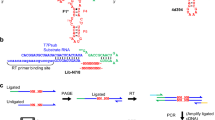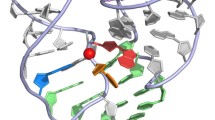Abstract
The RNA World theory encompasses the hypothesis that sophisticated ribozymes and riboswitches were the primary drivers of metabolic processes in ancient organisms. Several types of catalytic RNAs and many classes of ligand-sensing RNA switches still exist in modern cells. Curiously, allosteric ribozymes formed by the merger of RNA enzyme and RNA switch components are largely absent in today’s biological systems. This is true despite the striking abundances of various classes of both self-cleaving ribozymes and riboswitch aptamers. Here we present the known types of ligand-controlled ribozymes and riboswitches and discuss the possible reasons why fused ribozyme–aptamer constructs have been disfavored through evolution.






Similar content being viewed by others
References
Motlagh, H. N., Wrabl, J. O., Li, J. & Hilser, V. J. The ensemble nature of allostery. Nature 508, 331–339 (2014).
Liu, J. & Nussinov, R. Allostery: an overview of its history, concepts, methods and applications. PLoS Comput. Biol. 12, e1004966 (2016).
Dokholyan, N. V. Controlling allosteric networks in proteins. Chem. Rev. 116, 6463–6487 (2016).
Tang, J. & Breaker, R. R. Rational design of allosteric ribozymes. Chem. Biol. 4, 453–459 (1997).
Araki, M., Okuno, Y., Hara, Y. & Sugiura, Y. Allosteric regulation of a ribozyme activity through ligand-induced conformational change. Nucleic Acids Res. 26, 3379–3384 (1998).
Soukup, G. A. & Breaker, R. R. Engineering precision RNA molecular switches. Proc. Natl Acad. Sci. USA 96, 3584–3589 (1999).
Jose, A. M., Soukup, G. A. & Breaker, R. R. Cooperative binding of effectors by an allosteric ribozyme. Nucleic Acids Res. 29, 1631–1637 (2001).
Thompson, K. M., Syrett, H. A., Knudsen, S. M. & Ellington, A. D. Group I aptazymes as genetic regulatory switches. BMC Biotechnol. 2, 21 (2002).
Felletti, M. & Hartig, J. S. Ligand-dependent ribozymes. Wiley Interdiscip. Rev. RNA 8, e1395 (2017).
Walter, J. G. & Stahl, F. in Catalytically Active Nucleic Acids. Advances in Biochemical Engineering/Biotechnology Vol. 170 (eds Seitz, H. et al.) (Springer, 2019).
Gilbert, W. Origin of life: the RNA world. Nature 319, 618 (1986).
Robertson, M. P. & Joyce, G. F. The origins of the RNA World. Cold Spring Harb. Perspect. Biol. 4, a003608 (2012).
Benner, S. A., Ellington, A. D. & Tauer, A. Modern metabolism as a palimpsest of the RNA world. Proc. Natl Acad. Sci. USA 86, 7054–7058 (1989). The arguments presented in this Perspective provide strong support for the hypothesis that RNA World organisms ran a complex metabolic state by using enzymes made of RNA.
Chen, X., Li, N. & Ellington, A. D. Ribozyme catalysis of metabolism in the RNA World. Chem. Biodivers. 4, 633–655 (2007).
White, H. B. III Coenzymes as fossils of an earlier metabolic state. J. Mol. Evol. 7, 101–104 (1976).
Breaker, R. R. Prospects for riboswitch discovery and analysis. Mol. Cell 43, 867–879 (2011).
McCown, P. J., Corbino, K. A., Stav, S., Sherlock, M. E. & Breaker, R. R. Riboswitch diversity and distribution. RNA 23, 995–1011 (2017). This Review presents most of the riboswitches classes that have been discovered to date, along with a proposal that thousands more riboswitch classes remain hidden among bacterial genomes.
Vitreschak, A. G., Rodionov, D. A., Mironov, A. A. & Gelfand, M. S. Riboswitches: the oldest mechanism for the regulation of gene expression? Trends Genet. 20, 44–50 (2004).
Breaker, R. R. Riboswitches and the RNA World. Cold Spring Harb. Perspect. Biol. 4, a003566 (2012).
Breaker, R. R. Imaginary ribozymes. ACS Chem. Biol. 15, 2020–2030 (2020).
Nelson, J. W. & Breaker, R. R. The lost language of the RNA World. Sci. Signal. 10, eaam8812 (2017).
Jimenez, R. M., Polanco, J. A. & Lupták, A. Chemistry and biology of self-cleaving ribozymes. Trends Biochem. Sci. 40, 648–661 (2015).
Perreault, J. et al. Identification of hammerhead ribozymes in all domains of life reveals novel structural variations. PLoS Comput. Biol. 7, e1002031 (2011).
Hammann, C., Lupták, A., Perreault, J. & de la Peña, M. The ubiquitous hammerhead ribozyme. RNA 18, 871–885 (2012).
Webb, C. H., Riccitelli, N. J., Ruminski, D. J. & Lupták, A. Widespread occurrence of self-cleaving ribozymes. Science 326, 953 (2009).
Roth, A. et al. A widespread self-cleaving ribozyme is revealed by bioinformatics. Nat. Chem. Biol. 10, 56–60 (2014).
Lee, E. R., Baker, J. L., Weinberg, Z., Sudarsan, N. & Breaker, R. R. An allosteric self-splicing ribozyme triggered by a bacterial second messenger. Science 329, 845–848 (2010).
Schmidt, C. M. & Smolke, C. D. RNA switches for synthetic biology. Cold Spring Harb. Perspect. Biol. 11, a032532 (2019).
Yokobayashi, Y. Aptamer-based and aptazyme-based riboswitches in mammalian cells. Curr. Opin. Chem. Biol. 52, 72–78 (2019). Refs. 28 and 29 provide overviews of the various practical applications of engineered RNA switches, including allosteric ribozymes.
Barrick, J. E. & Breaker, R. R. The distributions, mechanisms and structures of metabolite-binding riboswitches. Genome Biol. 8, R239 (2007).
Yarnell, W. S. & Roberts, J. W. Mechanism of intrinsic transcription termination and antitermination. Science 284, 611–615 (1999).
Gusarov, I. & Nudler, E. The mechanism of intrinsic transcription termination. Mol. Cell 3, 495–504 (1999).
Omotajo, D., Tate, T., Cho, H. & Choudhary, M. Distribution and diversity of ribosome binding sites in prokaryotic genomes. BMC Genomics 16, 604 (2015).
Schneider, T. D., Stormo, G. D., Gold, L. & Ehrenfeucht, A. Information content of binding sites on nucleotide sequences. J. Mol. Biol. 188, 415–431 (1986).
Nissen, J., Hansen, J., Ban, N., Moore, P. B. & Steitz, T. A. The structural basis of ribosome activity in peptide bond synthesis. Science 289, 920–930 (2000).
Cech, T. R. The ribosome is a ribozyme. Science 289, 878–879 (2000).
Winkler, W. C., Nahvi, A., Roth, A., Collins, J. A. & Breaker, R. R. Control of gene expression by a natural metabolite-responsive ribozyme. Nature 428, 281–286 (2004).
McCown, P. J., Roth, A. & Breaker, R. R. An expanded collection and refined consensus model of glmS ribozymes. RNA 17, 728–736 (2011).
Collins, J. A., Irnov, I., Baker, S. & Winkler, W. C. Mechanism of mRNA destabilization by the glmS ribozyme. Genes Dev. 21, 3356–3368 (2007).
McCarthy, T. J. et al. Ligand requirements for glmS ribozyme self-cleavage. Chem. Biol. 12, 1221–1226 (2005).
Viladoms, J. & Fedor, M. J. The glmS ribozyme cofactor is a general acid-base catalyst. J. Am. Chem. Soc. 134, 19043–19049 (2012).
McCown, P. J., Winkler, W. C. & Breaker, R. R. Mechanism and distribution of glmS ribozymes. Methods Mol. Biol. 848, 113–129 (2012).
Cochrane, J. C., Lipchock, S. V., Smith, K. D. & Strobel, S. A. Structural and chemical basis for glucosamine 6-phosphate binding and activation of the glmS ribozyme. Biochemistry 48, 3239–3246 (2009).
Klein, D. J. & Ferré-D’Amaré, A. R. Structural basis of glmS ribozyme activation by glucosamine-6-phosphate activation. Science 313, 1752–1756 (2006). The modified sugar glucosamine-6-phosphate activates ribozyme self-cleavage by serving as a cofactor and not by functioning as an allosteric effector.
Bennett, B. D. et al. Absolute metabolite concentrations and implied enzyme active site occupancy in Escherichia coli. Nat. Chem. Biol. 5, 593–599 (2009).
Watson, P. Y. & Fedor, M. J. The glmS riboswitch integrates signals from activating and inhibitory metabolites in vivo. Nat. Struct. Mol. Biol. 18, 359–363 (2011). The findings described in this report reveal that glucose affects glmS ribozyme function by competitive inhibition, but not by an allosteric mechanism.
Cech, T. R. Self-splicing of group I introns. Annu. Rev. Biochem. 59, 543–568 (1990).
Hernández-Morales, R., Becerra, A. & Lazcano, A. Alarmones as vestiges of a bygone RNA World. J. Mol. Evol. 87, 37–51 (2019).
Sudarsan, N. et al. Riboswitches in eubacteria sense the second messenger cyclic di-GMP. Science 321, 411–413 (2008).
Lee, E. R., Baker, J. L., Weinberg, Z., Sudarsan, N. & Breaker, R. R. Anallosteric self-splicing ribozyme triggered by a bacterial second messenger. Science 329, 845–848 (2010). The only known allosteric ribozyme found in modern cells senses the signaling molecule c-di-GMP to regulate splicing by a group I ribozyme.
Sherlock, M. E., Sudarsan, N. & Breaker, R. R. Riboswitches for the alarmone ppGpp expand the collection of RNA-based signaling systems. Proc. Natl Acad. Sci. USA 115, 6052–6057 (2018).
Yarus, M. A specific amino acid binding site composed of RNA. Science 240, 1751–1758 (1988).
Sudarsan, N., Barrick, J. E. & Breaker, R. R. Metabolite-binding RNA domains are present in the genes of eukaryotes. RNA 9, 644–647 (2003).
Kubodera, T. et al. Thiamine-regulated gene expression of Aspergillus oryzae thiA requires splicing of the intron containing a riboswitch-like domain in the 5′-UTR. FEBS Lett. 555, 516–520 (2003).
Cheah, M. T., Wachter, A., Sudarsan, N. & Breaker, R. R. Control of alternative RNA splicing and gene expression by eukaryotic riboswitches. Nature 447, 497–500 (2007). Riboswitches can control alternative splicing by regulating eukaryotic spliceosome access to pre-mRNA substrates, which could be considered an allosteric ribosome control in trans.
Wachter, A. et al. Riboswitch control of gene expression in plants by splicing and alternative 3′ end processing of mRNAs. Plant Cell 19, 3437–3450 (2007).
Bocobza, S. et al. Riboswitch-dependent gene regulation and its evolution in the plant kingdom. Genes Dev. 21, 2874–2879 (2007).
Croft, M. T., Moulin, M., Webb, M. E. & Smith, A. G. Thiamine biosynthesis in algae is regulated by riboswitches. Proc. Natl Acad. Sci. USA 104, 20770–20775 (2007).
Li, S. & Breaker, R. R. Eukaryotic TPP riboswitch regulation of alternative splicing involving long-distance base pairing. Nucleic Acids Res. 41, 3022–3031 (2013).
Fica, S. M. et al. RNA catalyzes nuclear pre-mRNA splicing. Nature 503, 229–234 (2013).
Chen, A. G. Y., Sudarsan, N. & Breaker, R. R. Mechanism for gene control by a natural allosteric group I ribozyme. RNA 17, 1967–1972 (2011).
Sudarsan, N. et al. Tandem riboswitch architectures exhibit complex gene control functions. Science 314, 300–304 (2006).
Stoddard, C. D. & Batey, R. T. Mix-and-match riboswitches. ACS Chem. Biol. 1, 751–754 (2006).
Breaker, R. R. Complex riboswitches. Science 319, 1795–1797 (2008).
Sherlock, M. E., Sudarsan, N., Stav, S. & Breaker, R. R. Tandem riboswitches form a natural Boolean logic gate to control purine metabolism in bacteria. eLife 7, e33908 (2018).
Hausner, G., Hafez, M. & Edgell, D. R. Bacterial group I introns: mobile RNA catalysts. Mob. DNA 5, 8 (2014).
Lambowitz, A. M. & Zimmerly, S. Group II introns: mobile ribozymes that invade DNA. Cold Spring Harb. Perspect. Biol. 3, a003616 (2011).
Wang, L. et al. Allosteric control of the ribosome by small-molecule antibiotics. Nat. Struct. Mol. Biol. 19, 957–963 (2010).
Fagan, C. E. et al. Reorganization of an intersubunit bridge induced by disparate 16S ribosomal ambiguity mutations mimics an EF-Tu-bound state. Proc. Natl Acad. Sci. USA 110, 9716–9721 (2013).
Moore, P. B. Ribosomal ambiguity made less ambiguous. Proc. Natl Acad. Sci. USA 110, 9627–9628 (2013).
Passalacqua, L. F. M., Jimenez, R. M., Fong, J. Y. & Lupták, A. Allosteric modulation of the Faecalibacterium prausnitzii hepatitis delta virus-like ribozyme by glucosamine 6-phosphate: the substrate of the adjacent gene. Biochemistry 56, 6006–6014 (2017).
Tang, J. & Breaker, R. R. Structural diversity of self-cleaving ribozymes. Proc. Natl Acad. Sci. USA 97, 5784–5789 (2000).
Link, K. H. & Breaker, R. R. Engineering ligand-responsive gene control elements: lessons learned from natural riboswitches. Gene Ther. 16, 1189–1201 (2009).
Acknowledgements
We thank K. Harris, A. Roth, N. Sudarsan and Y. Yang for critically reading the manuscript. This work was supported by NIH grants (GM022778 and AI136794) as well as funds from Howard Hughes Medical Institute.
Author information
Authors and Affiliations
Corresponding author
Ethics declarations
Competing interests
The authors declare no competing interests.
Additional information
Publisher’s note Springer Nature remains neutral with regard to jurisdictional claims in published maps and institutional affiliations.
Rights and permissions
About this article
Cite this article
Panchapakesan, S.S.S., Breaker, R.R. The case of the missing allosteric ribozymes. Nat Chem Biol 17, 375–382 (2021). https://doi.org/10.1038/s41589-020-00713-2
Received:
Accepted:
Published:
Issue Date:
DOI: https://doi.org/10.1038/s41589-020-00713-2
- Springer Nature America, Inc.
This article is cited by
-
Structure and mechanism of the methyltransferase ribozyme MTR1
Nature Chemical Biology (2022)





